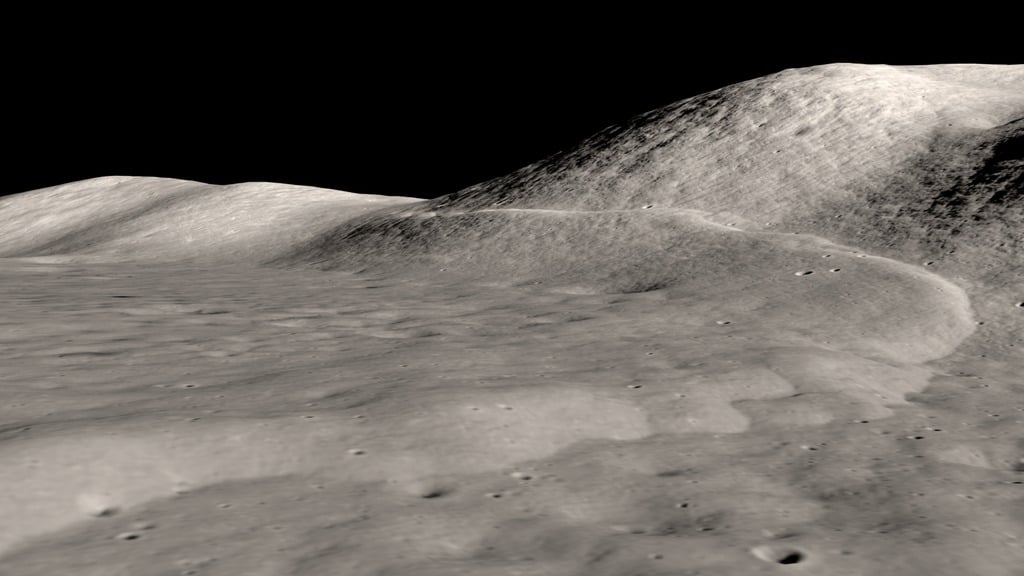Science
Moonquakes Threaten Safety of Future Lunar Bases, Experts Warn

The Moon’s seismic activity poses significant risks to the construction and sustainability of future permanent lunar bases. A recent study highlights the potential dangers of moonquakes, particularly along the Lee-Lincoln fault in the Taurus-Littrow Valley, a site explored by the Apollo 17 mission in December 1972. Researchers, including lead author and Smithsonian senior scientist emeritus Thomas R. Watters, emphasize that the lunar environment is still geologically active, which could impact long-term human habitation.
Research conducted by Watters and Nicholas Schmerr from the University of Maryland focused on geological evidence collected from the Apollo 17 landing site. Their findings reveal a history of moonquakes in the region extending back approximately 90 million years, with numerous young thrust faults indicating ongoing geological activity. “The global distribution of young thrust faults like the Lee-Lincoln fault needs to be considered when planning the location and assessing the stability of permanent outposts on the Moon,” Watters stated.
Moonquakes, unlike earthquakes, arise primarily from two factors: tidal forces exerted by the Earth and the Moon’s continuous cooling and contraction. Tidal quakes, caused by Earth’s gravitational pull, can occur deep within the Moon, while shallower quakes are attributed to lunar shrinkage. Over billions of years, the Moon has lost about 150 feet in diameter due to this gradual cooling. Minor tremors can also result from impacts by meteoroids or thermal reactions of surface materials.
The implications of these findings are crucial for future lunar missions. While short-duration missions, such as the Apollo landings, had limited exposure to seismic risks, permanent bases will face a higher likelihood of experiencing damaging quakes over extended periods. Schmerr noted, “For astronauts present for a day, a damaging event would be a matter of very bad luck. However, for a crewed mission lasting a decade, the risk of a hazardous moonquake increases significantly.”
The study indicates that the probability of significant seismic events can shift dramatically based on mission duration. For example, the risk of experiencing a damaging moonquake during a ten-year mission translates to approximately 1 in 5,500, a stark contrast to the extremely low odds of winning a lottery.
Additionally, the risks extend beyond habitats and crewed missions. Countries, including Russia, China, and the United States, are considering establishing nuclear power plants on the Moon to support exploration efforts. The potential for seismic activity raises concerns about the structural integrity of these facilities, necessitating rigorous safety measures and careful site selection to avoid active fault lines.
As scientists continue their research on lunar paleoseismology, they aim to gather evidence of historical earthquakes, which will be instrumental in determining the safest locations for future bases, habitats, and power plants. The study of past quakes, combined with the analysis of recent seismic activity, will play a vital role in assessing the Moon’s geological landscape.
The findings from the Taurus-Littrow Valley underscore the importance of thorough geological assessments in lunar exploration planning. Understanding the Moon’s seismic landscape will be critical for ensuring the safety and sustainability of human activities on this celestial body. With ongoing advancements in space exploration, addressing these geological challenges will be essential for the success of future lunar missions.
-

 Lifestyle3 months ago
Lifestyle3 months agoLibraries Challenge Rising E-Book Costs Amid Growing Demand
-

 Sports3 months ago
Sports3 months agoTyreek Hill Responds to Tua Tagovailoa’s Comments on Team Dynamics
-

 Sports3 months ago
Sports3 months agoLiverpool Secures Agreement to Sign Young Striker Will Wright
-

 Lifestyle3 months ago
Lifestyle3 months agoSave Your Split Tomatoes: Expert Tips for Gardeners
-

 Lifestyle3 months ago
Lifestyle3 months agoPrincess Beatrice’s Daughter Athena Joins Siblings at London Parade
-

 World3 months ago
World3 months agoWinter Storms Lash New South Wales with Snow, Flood Risks
-

 Science3 months ago
Science3 months agoTrump Administration Moves to Repeal Key Climate Regulation
-

 Science2 months ago
Science2 months agoSan Francisco Hosts Unique Contest to Identify “Performative Males”
-

 Business3 months ago
Business3 months agoSoFi Technologies Shares Slip 2% Following Insider Stock Sale
-

 Science3 months ago
Science3 months agoNew Tool Reveals Link Between Horse Coat Condition and Parasites
-

 Sports3 months ago
Sports3 months agoElon Musk Sculpture Travels From Utah to Yosemite National Park
-

 Science3 months ago
Science3 months agoNew Study Confirms Humans Transported Stonehenge Bluestones









